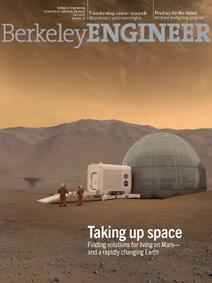Digging deep
The unassuming Pacific mole crab, Emerita analoga, is about to make some waves. Berkeley Engineering researchers have debuted a robot inspired by this crustacean that may help evaluate soil and rock conditions, as well as collect marine data.
Hannah Stuart, assistant professor of mechanical engineering, and her team demonstrated one of the first legged robots that can self-burrow vertically. This digging robot, called EMBUR (EMerita BUrrowing Robot), uses a novel leg design that emulates the way Pacific mole crabs bury themselves in beach sand.
Mole crabs make burrowing look easy, but, according to Ph.D. student Laura Treers, it is difficult to move downward through granular media, like sand and soil. To overcome this challenge, the researchers designed the legs of the robot to have an anisotropic force response, which means that they experience much greater force in one direction than another. Like a swimmer, the soft fabric legs of this robot expand for large forces during the power stroke, but fold and retract during the return stroke.
To design the legs on EMBUR, the researchers worked with Robert Full, professor of electrical engineering and computer sciences and of integrative biology, and Ph.D. student Benjamin McInroe to observe mole crabs in the lab. They realized that the animal’s five leg pairs can be split into two groups, which sweep in opposite directions. They also noticed a pattern of insertion, sweeping and retraction, with the latter appearing to reduce drag on the return stroke. The team then reproduced both features in the robot’s leg design, using physics models to estimate the forces on the legs.
The researchers also devised a way to prevent sand grains from entering the robot’s mechanisms and jamming them. “We created a cuticle, which is analogous to the arthrodial membrane found on the mole crabs,” said Treers. “It’s a soft, flexible material that lines the openings of joints to prevent grains from getting inside but still allows free movement.”
The researchers consider EMBUR a first step toward creating a system that can burrow under a wider range of conditions and types of substrates. “Eventually, I’d love to have this robot be able to dig in real beach settings, like the animal, and switch between running, swimming and digging,” said Treers.
Learn more: Digging deep; Mole crab-inspired vertical self-burrowing (Frontiers in Robotics and AI)

